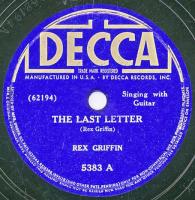
HiramKing "Hank" Williams was an American singer-songwriter. He is regarded as one of the most significant and influential American singers and songwriters of the 20th century. Williams recorded 55 singles that reached the top 10 of the Billboard Country & Western Best Sellers chart, five of which were released posthumously, and 12 of which reached No.1.
"Jambalaya (On the Bayou)" is a song written and recorded by American country music singer Hank Williams that was first released in July 1952. It is Williams' most recorded song. Named for a Creole and Cajun dish, jambalaya, it spawned numerous recordings and has since achieved popularity in several different music genres.
"Cold, Cold Heart" is a country music and pop song written and first recorded by Hank Williams. This blues ballad is both a classic of honky-tonk and an entry in the Great American Songbook.

"Hey, Good Lookin'" is a 1951 song written and recorded by Hank Williams, and his version was inducted into the Grammy Hall of Fame in 2001. In 2003, CMT voted the Hank Williams version No. 19 on CMT's 100 Greatest Songs of Country Music. Since its original 1951 recording it has been covered by a variety of artists.
"Move It On Over" is a song written and recorded by the American country music singer-songwriter Hank Williams in 1947.
"I'm So Lonesome I Could Cry" is a song written and recorded by American country music singer-songwriter Hank Williams in 1949. The song has been covered by a wide range of musicians.

"Kaw-Liga" is a country music song written by Hank Williams and Fred Rose.
"Honky Tonk Blues" was a hit country and western song written and performed by Hank Williams. The original 1952 recording was a major hit, and it later became a hit for Charley Pride.
"Take These Chains from My Heart" is a song by Hank Williams. It was written by Fred Rose and Hy Heath and was recorded at Williams' final recording session on September 23, 1952, in Nashville. The song has been widely praised; Williams' biographer Colin Escott deems it "perhaps the best song [Rose] ever presented to Hank...It was one of the very few songs that sounded somewhat similar to a Hank Williams song." Williams is backed by Tommy Jackson (fiddle), Don Helms, Chet Atkins, Jack Shook, and Floyd "Lightnin'" Chance (bass). In the wake of Williams' death on New Year's Day, 1953, the song shot to No. 1, his final chart-topping hit for MGM Records. Like "Your Cheatin' Heart," the song's theme of despair, so vividly articulated by Williams' typically impassioned singing, reinforced the image of Hank as a tortured, mythic figure.
"You Win Again" is a 1952 song by Hank Williams. In style, the song is a blues ballad and deals with the singer's despair with his partner. The song has been widely covered, including versions by Ray Charles, Jerry Lee Lewis, Roy Orbison, the Grateful Dead, Charley Pride, Bob Dylan, and the Rolling Stones.
"Honky Tonkin'" is a 1947 country music song, written and recorded by Hank Williams. His song went to #14 on the Billboard country music chart in 1948. In 1982, it became the sixth chart topping single for Williams' son, Hank Williams Jr.
"My Bucket's Got a Hole in It" is a song widely attributed to Clarence Williams, who obtained a copyright in 1933, although the melody was recorded under various names years earlier. The song became popular performed by Hank Williams for MGM and reached number 4 on the country chart in 1949.

"The Last Letter" is a song written by country music singer Rex Griffin. Griffin wrote the song in 1937, after he was left by his wife. The song tells through a suicidal letter the feelings of an older man who is left by his young wife. The song, released on Decca Records became a hit for Griffin.
"A Mansion on the Hill" is a song written by Hank Williams and Fred Rose and originally recorded by Williams on MGM Records. It peaked at No. 12 on the Most Played Jukebox Folk Records chart in March 1949.
"(Last Night) I Heard You Crying in Your Sleep" is a song written and recorded by Hank Williams on MGM Records. It was released as the B-side of "Move It on Over" in 1947.
Six More Miles (To the Graveyard) is a song written by Hank Williams for MGM Records. It appeared as the B-side to "I Saw the Light" in 1948.
"My Son Calls Another Man Daddy" is a song written by Jewell House and made famous by country star Hank Williams, who released the song in 1950.

Memorial Album is the first Hank Williams LP issued by MGM Records after the singer's death on New Year's Day 1953.
"House of Gold" is a hymn written by Hank Williams. It was released by MGM Records as the B-side to "How Can You Refuse Him Now?" in 1954. It was recorded as a demo when Williams worked the Louisiana Hayride in Shreveport between August 1948 and May 1949. The song admonishes those who "steal, cheat, and lie" in pursuit of material wealth rather than finding salvation in God. Despite being a posthumous single that he never recorded with his band in a studio, "A House of Gold" became one of Hank's most covered hymns.
"Blue Love (In My Heart)" is a song written by Fred Rose (credited under the pseudonym "Floyd Jenkins") and recorded by Hank Williams. It was released as a posthumous single by MGM Records in 1956. Williams recorded the song while living in Shreveport working the Louisiana Hayride in 1948 and 1949. It was one of his several Rose compositions he performed on the Johnny Fair Syrup radio show on KWKH in Shreveport. Rose produced Hank's records and published his songs through his company Acuff-Rose.





